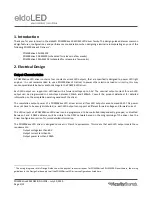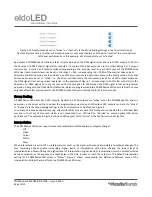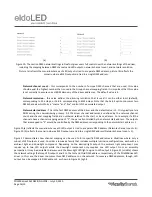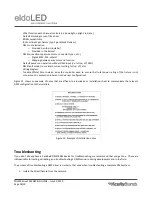
POWERdrive 50W DESIGN GUIDE
–
July 30, 2020
Page 13/19
By default, a POWERdrive LED driver retains its last value when the DMX signal is lost and sets all LED outputs to 20% in
the absence of a DMX control signal after cold start. To overwrite this behavior, the user must first define 1 or 2 unique
static scenes. A scene has 4 output entries corresponding to the intensity level for each LED output of the POWERdrive
LED driver. Each intensity level can be set in the range 0
–
255, corresponding to 0
–
100% of the nominal drive current.
Fail mode and Startup mode are then tied to one of the two scenes via a pull-down menu in the Config section. Note that
Fail mode can also be set to
“
retain
”
, i.e. the driver will then retain the last intensity levels for all LED outputs whenever
the DMX signal is lost during normal operation. In the example of Figure 7, all outputs go to 100% after cold start (in the
absence of a DMX signal) but only the second LED output goes to 100% when the DMX signal is lost during normal
operation. Changes to the DMX startup/fail mode, which are programmed into a POWERdrive LED driver via FluxTool, may
only take effect after mains power to the POWERdrive LED driver is interrupted for at least 3 seconds.
Group Scaling
A POWERdrive LED driver has 4 LED outputs. By default, all LED outputs are
“
active
”
when the POWERdrive LED driver is
powered, i.e. the driver will try to deliver the programmed current to each LED output. LED outputs can be set to
“
active
”
or
“
inactive
”
via the Group Scaling settings in the Control section of FluxTool, see Figure 8.
In a variety of luminaire applications (e.g. direct-color RGB) only a subset of LED outputs is connected to an LED load. Best
practice is to set any LED output, which is not connected to an LED load, to
“
inactive
”
to ensure optimal LED driver
performance. The example in Figure 8 shows all LED outputs set to
“
active
”
in the Control section of FluxTool.
Interpolation
The POWERdrive LED driver supports several interpolation methods between setpoint changes:
-
Off
-
Video
-
Colour
-
White
-
Glow
When interpolation is set to Off, no interpolation is used, i.e. the driver will respond immediately to setpoint changes. The
four remaining options enable increasingly higher levels of interpolation with Video offering the lowest level of
interpolation and Glow offering the highest level of interpolation. Higher levels of interpolation result in smoother fades
between setpoints at the expense of a slight delay in the time it takes to reach the setpoints. The default interpolation
setting for a POWERdrive LED driver is
“
Colour
”
. Figure 9 shows, conceptually, the difference between some of the
interpolation settings that are offered in a POWERdrive LED driver.
Figure 8: LED outputs can be set to
“
active
”
or
“
inactive
”
via the Group Scaling settings in the Control section of
FluxTool. Best practice is to set any LED output, which is not connected to an LED load, to
“
inactive
”
to ensure optimal
LED driver performance. In this example, all LED outputs are set to
“
active
”
.





































